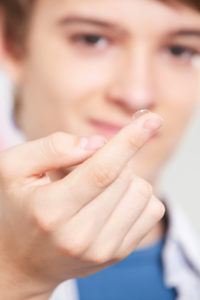
February 16, 2021
By Dwight Akerman, OD, MBA
Eye care professionals are often hesitant to prescribe standard or myopia management soft contact lenses for children because of concerns over potential adverse events. Woods and co-researchers investigated the ocular health and safety of children fit with soft hydrogel daily disposable contact lenses to alleviate these concerns. Study participants were 8-12 years old at initial fitting and were followed for six years in a double-masked clinical trial investigating the performance of a dual-focus contact lens designed to control myopia progression.
No contact lens-related adverse events were classified as serious. The most common biomicroscopy findings were limbal, bulbar and tarsal hyperemia and tarsal roughness; 99 percent of all biomicroscopy findings were grade-1 or lower. After six years of lens wear, ocular health assessed by biomicroscopy was similar to pre-lens wear.
The researchers concluded that children can successfully wear daily disposable hydrogel contact lenses with minimal impact on ocular physiology.
Abstract
Ocular health of children wearing daily disposable contact lenses over a six-year period
Jill Woods, Debbie Jones, Lyndon Jones, Susanna Jones, Chris Hunt, Paul Chamberlain, John McNally
Purpose: To report on the ocular health and safety of children fit with soft hydrogel daily disposable contact lenses and followed for six years in a double-masked clinical trial investigating the performance of a dual-focus contact lens designed to control myopia progression.
Methods: Children aged 8−12 years, naïve to contact lens wear, were enrolled across four international sites. During years one to three, children were randomized to either MiSight 1 day or Proclear 1 day (both omafilcon A, CooperVision, Inc.). The lenses were identical in material and geometry except for the front optical zone design. At the end of year three, all those wearing Proclear 1 day were switched to MiSight 1 day, therefore all wore MiSight 1 day in years four to six. Subjects agreed to wear the lenses at least 10 hours per day, six days per week. After dispensing, study visits were at one week, one month, six months, and every six months until six years. At each visit, ocular measurements and subjective responses were recorded. Biomicroscopy used 0-4 grading scales; grade 0 represented no findings.
Results: 144 children were enrolled: 69F:75M; mean age 10.1 years; mean cycloplegic spherical-equivalent refraction -2.11D; ethnicities included 34 East-Asian, 12 West-Asian, and 79 Caucasian; 92 completed the six years. Only three subjects discontinued due to an ocular adverse event (AE). No contact lens-related AEs were classified as serious. The incidence rate of infiltrative AEs was 0.61 percent (6.1/1,000 wearing-years; 95 percent CI: 0.24 percent – 1.57 percent). The most common biomicroscopy findings were limbal, bulbar and tarsal hyperaemia and tarsal roughness. 99 percent of all biomicroscopy findings were grade-1 or lower. After six years of lens wear, ocular health by biomicroscopy was similar to pre-lens wear.
Conclusions: Across the six years, there was no contact lens-related serious AEs, and biomicroscopy showed no significant changes. Results suggest that children this age can successfully wear daily disposable hydrogel contact lenses with minimal impact on ocular physiology.
Woods, J., Jones, D., Jones, L., Jones, S., Hunt, C., Chamberlain, P., & McNally, J. (2021). Ocular health of children wearing daily disposable contact lenses over a 6-year period. Contact Lens and Anterior Eye.
DOI: https://doi.org/10.1016/j.clae.2020.11.011













